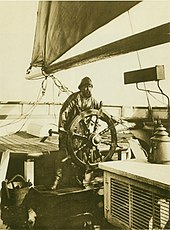Oilskins

Oilskins ( Engl. : Oilskin ) referred weatherproof outerwear in seafaring , which is to protect the wearer from wind and rain.
Originally these clothes were made from a linen fabric , the surface of which was impregnated with oil, often linseed oil , to make it waterproof . From the middle of the 19th century, rubber was also used to seal the fabric. Regular post-treatment with oil or wax was necessary in order to maintain the watertightness.
With the invention of vulcanization by Charles Goodyear, it was possible for the first time to produce permanently waterproof and stable textiles with a rubber coating . With the advent of synthetic plastics such as PVC in the 20th century, the rubberized fabric came out of fashion again, as it was relatively heavy and not sufficiently resistant to tar, oil and grease.
Although the garments for sailors these days of modern synthetic fabrics such as Gore-Tex or Sympatex are made, the old name has still partially oilskins for sailors clothing received.
Oilskins are divided into different classes. A distinction is made between light oilskin, which is waterproof but breathable, and heavy oilskin, which is made from stronger materials. Fabrics are laminated on two sides of a membrane .
In Australia, rainwear for riders is still made from oilcloth , which is known nationally under the company name Driza-Bone .
A typical headgear for sailors made of oilcloth is called a southwest , a hat with a wide brim to divert the rain.
source
- Joachim Schult: Sailors Lexicon. Delius-Klasing-Verlag, Bielefeld 2008, ISBN 978-3-7688-1041-8 ; Keyword oilskin .
